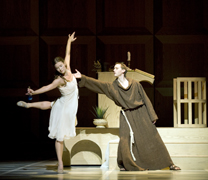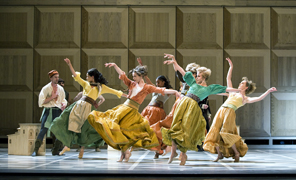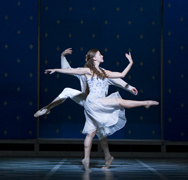
Jack Anderson
Mark Morris's Shakespeare
Mark Morris Dance Group
"Romeo & Juliet, On Motifs of Shakespeare"
Rose Theater, Home of Jazz at Lincoln Center
May 14-17, 2009
Thursday through Saturday at 8 p.m.; Sunday at 3 p.m.; $30-$90
Tickets: (212) 721-6500 or www.lincolncenter.org
Reviewed by Jack Anderson, May 16, 2009
 |
| Mark Morris. Photo by Amber Darragh, 2007 |
With so many dull versions of Prokofiev's "Romeo and Juliet" around, the prospect of a new one does not automatically warm the hearts of seasoned (or should I say jaded?) dancegoers, who might well exclaim, "Must we have to sit through this stuff again?" And when Mark Morris announced his own "Romeo," his basic notion sounded gimmicky. He proposed staging Prokofiev's never produced original version, complete with happy ending. That might have made despairing dancegoers cry, "Do we have to sit through this even once?" Fortunately, it proved (at least, most of it did) well worth sitting through. "Romeo & Juliet, On Motifs of Shakespeare" was the first "Romeo" I've seen in a long time that made me really curious about what would come next.
 |
| Rita Donahue and John Heginbotham. Photo by Gene Schiavone. |
Simon Morrison's restoration of the original score makes the music sound taut and lighter in texture than the familiar orchestration. Stefan Asbury, conducting the Orchestra of St. Luke's, made it move along with gusto. Morris's choreography is similarly fast-paced. This is a swift, lean, youthful "Romeo." Almost everyone looks young. Even Lauren Grant's Nurse is a bit of a minx. The accent on youth possibly justifies one of Morris's oddest decisions: casting women as both Mercutio (Elisa Clark) and Tybalt (Julie Worden). This may not be non-traditional casting merely for the sake of non-traditional casting. Having women in these roles makes them seem boyish and reminds us that Shakespeare's young people are kids who find themselves playing fatal games.
 |
| Women of Verona in "Romeo & Juliet, On Motifs of Shakespeare." Photo by Gene Schiavone. |
Romeo (Noah Vinson) and Juliet (Maile Okamura) are not just dancers playing young lovers: they look like young lovers, and Morris has provided them with some nice choreographic touches. When they first meet, they dance happily on, but time stops around them, for everyone else stands frozen. There is no balcony scene; at least, no balcony. Allen Moyer's almost too simplistic scenery is just a set of panels that can open and close as needed. But do we really need a balcony for the "balcony pas de deux?" In most productions, Juliet enters on a balcony, then almost immediately descends to dance with Romeo on the ground, although, as I recall, in Antony Tudor's "Romeo" (to music by Delius), Juliet stays up there, and the balcony thereby becomes a symbol of the forces separating the lovers.
Morris's bedroom pas de deux is especially appealing: a simultaneously erotic and innocent duet, much of which does take place on a bed. These youngsters have had a lovely night together, and God bless them!
 |
| Rita Donahue and David Leventhal (covered). Photo by Gene Schiavone. |
Not all of Morris's choreography is felicitous. The impact of crowd scenes is lessened by the fact that this is a small company. Then there's that happy ending. Juliet, as usual, drinks her potion and seems to die. Romeo rushes in and attempts suicide, but Friar Laurence stops him. Juliet wakes, the lovers escape, and their families and friends enter the bedroom and are amazed to find an empty bed. But Romeo and Juliet are united dancing together against a starry sky.
This untraditional scenario, with hints of Christian Resurrection motifs, was apparently motivated by Prokofiev's spirituality (he was a Christian Scientist, and therefore would deny death) and by a desire to make Romeo and Juliet images of rebellious lovers defying oppression. Such a plot might well work choreographically, yet Morris never rises to its challenges, and his starry-sky pas de deux is almost totally devoid of ecstasy. Nevertheless, although he never arrives at his ballet's conceptual destination, his journey through Shakespeare's tale holds interest throughout.
| museums | NYTW mail | recordings | coupons | publications | classified |
